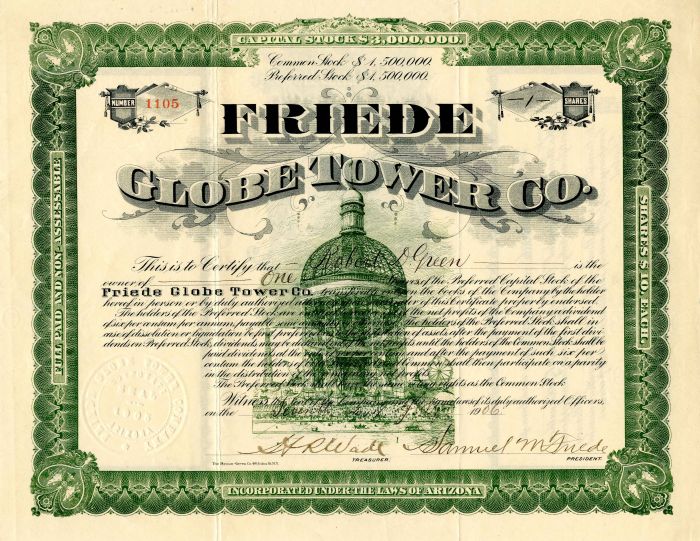Friede Globe Tower Co.
Inv# GS6147 Stock
One of the most ambitious and unusual amusement park projects for Coney Island was announced in a newspaper ad on May 6, 1906 in the New York Herald. It offered investors "a ground floor chance to share profits in the largest steel structure ever erected...the greatest amusement enterprise in the whole world...the best real estate venture," the Globe Tower. The ad explained that it would cost $1,500,000 to erect. The public was urged to invest on the expectations that it would pay 100 % interest annually. What Samuel Friede, the inventor of the Globe Tower, planned was enormous in scope. For him a structure in the shape of a globe or sphere that was subdivided into floors, was simply a source of immense square footage that needed a tiny point of contact with earth to support it. As he revealed to investors, the tower's blueprints showed a gigantic steel planet that had collided onto a replica of the Eiffel Tower. As a whole it was 700 feet high, three times as high as the Flatiron Building, New York's marvel at the time. The Globe Tower would be the largest building in the world with enormous elevators to carry visitors to its eleven completely different floors. It would be an agglomeration of Steeplechase, Dreamland and Luna Park, all contained in a single interior volume. Friede leased a small corner of the Steeplechase property on Surf Avenue to erect this colossal structure. The structure would be supported by eight enormous socles (pedestals) whose foundations would be 35 feet deep. Underground was planned as a multi-level interchange of various modes of transport: a combination parking garage, subway and railroad station with a branch heading out towards sea to connect with the boat pier. The Globe would be divided into eleven floors, beginning 150 feet above the ground and spaced at intervals of fifty feet. The lowest or first level would feature a Pedestal Roof Garden with a popular priced restaurant, continuous vaudeville theater, roller skating rink, bowling alley, slot machines, etc. At the 250 foot level there would be an Aerial Hippodrome seating 5000 people. It would feature four large circus rings and four immense animal cages; each ring representing a different continent. Performances would be continuous and a miniature railroad would circle the arena's perimeter. The Globe's Main Hall would be located at the 300 foot level. Here would be the largest ballroom in the world and a moving restaurant enclosed in glass. A revolving strip twenty-five feet wide would carry tables, kitchens and patrons around the outer edge of the Tower to give the effect of eating in an airborne dining car. Diners would have a moving panoramic view of Coney Island, the countryside and Greater New York. Friede, who envisioned continuous 24 hour use of his Globe Tower by its 50,000 temporary residents, planned a hotel floor at the sphere's equator. Rooms would be small but luxuriously equipped and padded with sound proofing for undisturbed sleep. Fried's floor layout implicitly used social stratification. The facilities were increasing refined and elegant the higher one would ascend. The level above at 350 feet would feature an Aerial Palm Garden, a more expensive restaurant with tables scattered in a palm garden with cascades of running water each screened from each other by shrubbery. It was to be arranged on the Italian Garden plan. The Observatory platform was at the 500 foot level. At the highest platform in New York visitors could use coin operated telescopes to see more than 50 miles. There would also be a souvenir stand and various small concessions. Near the tower's top at the 600 feet level would be the United States Weather Observation Bureau and Wireless Telegraph Station. It would be equipped with modern weather recording devices. And at the very top would be the largest revolving searchlight in the world. The tower itself, lit by thousands of electric lights, would resemble a gigantic tower of fire. There was a cornerstone laying ceremony on May 26, 1906. It was complete with speeches, band concerts and fireworks. There was a rush of investors at the Glove Tower Company office built next to the first socle. But by the end of the 1906 season, when the foundations were still incomplete, investors became anxious. Another ceremony was held on February 17, 1907. A band was on hand when they put the first piece of steel in position. The company claimed they were driving 800 concrete foundation piles, each 30 feet long and five feet in circumference. They promised that half of the eleven floor structure would be open to the public on May 15th and the remainder would be fully operational the following year. Meanwhile in March, George Tilyou, tired of the endless delays, threatened an injunction. A Brooklyn Supreme Court judge prevented it. None-the-less, by 1908 it became clear that the most impressive architectural project ever conceived was a fraud. Tilyou was left with the problem of removing thirty foundation piles on his property. The Friede Tower, if it had been built would have been the first single building in the world to claim the status of resort.
A stock certificate is issued by businesses, usually companies. A stock is part of the permanent finance of a business. Normally, they are never repaid, and the investor can recover his/her money only by selling to another investor. Most stocks, or also called shares, earn dividends, at the business's discretion, depending on how well it has traded. A stockholder or shareholder is a part-owner of the business that issued the stock certificates.










Ebay ID: labarre_galleries